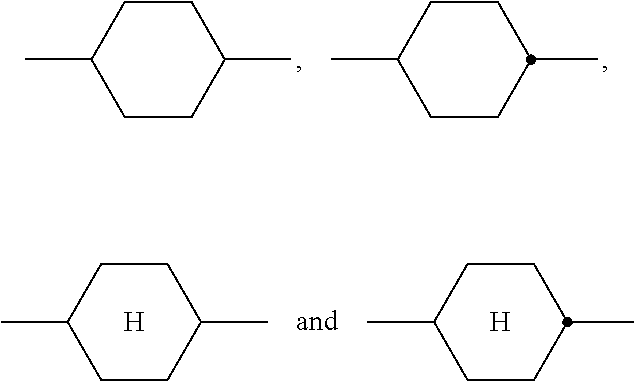Polymerizable compounds and the use thereof in liquid-crystal displays
a technology of polymerizable compounds and liquid crystal displays, which is applied in the direction of organic chemistry, instruments, chemistry apparatuses and processes, etc., can solve the problems of reducing the transparency of light, the lcds have the disadvantage of strong viewing angle dependence of contrast, and the response time is extended, so as to facilitate a quick and complete uv-photopolymerization reaction and reduce image sticking and odf mura in the display. , the effect o
- Summary
- Abstract
- Description
- Claims
- Application Information
AI Technical Summary
Benefits of technology
Problems solved by technology
Method used
Image
Examples
example 1
[0694]Compound 1 is prepared as following.
[0695]
[0696]1a: To a solution of isopropyl-triphenylphosphonium iodide (87.4 g, 0.2 mol) in 120 ml THF is added the solution of potassium tert-butylate (22.8 g; 0.2 mol) at max. 10° C. After stirred for 1 h, the solution of 4-bormo-benzaldehyde (34.0 g, 0.18 mol) in 30 ml THF is added at max. 10° C. The reaction mixture is allowed to warm up to room temperature and stirred overnight. After carefully neutralized with 2 M HCl, the reactive mixture is extracted three time with heptane. The organic phase is combined, dried over anhydrous sodium sulfate, and filtrated through silica gel. After removing solvent in vacuo, 1a is obtained at colorless oil (35.0 g).
[0697]1b: To a solution of 1a (35.0 g, 0.16 mol) and 4-benzoxylphenyl boronic acid (37.8 g, 0.16 mol) in 200 ml THF was added 110 ml dist. water and potassium carbonate (14.0 g, 0.25 mol). The resulted suspension is degassed carefully with argon, tris(dibenzylideneacetone)dipalladium(0) (0....
example 2
[0701]Compound 2 is prepared from the intermediate step 1c in the synthesis of Example 1 as following.
[0702]
[0703]2a: To a solution of 1c (6.00 g, 17.2 mmol) in 80 ml dichloromethane are added 4-(dimethylamino)pyridine (0.16 g, 1.3 mmol) and N-(3-dimethylaminopropyl)-N′-ethylcarbodiimidhydrochlorid (DAPECI) (4.1 g, 21.3 mmol). The reaction mixture is stirred at room temperature overnight. 100 ml water is added. The aqueous phase is extracted with dichloromethane. The organic phase is combined and dried over anhydrous sodium sulfate. After removing solvent in vacuo, the solid residue is purified by column chromatography with dichloromethane as eluent to provide 2a as white solid (6.4 g).
[0704]2b: A suspension of 2a (6.4 g, 12.6 mmol) in 70 ml THF is treated with palladium (5%) on activated charcoal (1.5 g) and submitted to hydrogenation for 10 hs. The catalyst is then filtered off. After removing solvent, the crude product is recrystallized from heptane / toluene solvent mixture to pro...
example 3
[0706]Compound 3 is prepared as following.
[0707]
[0708]3a: To a solution of 5-bromo-2-hydroxyl-phenyl-acetic acid methyl ester (5.0 g, 20.4 mmol) in 50 ml DCM is added trimethylamine (3.4 ml, 24.4 mmol) and 4-dimethylamino-pyridine (0.13 g, 1.08 mmol) at 0° C. A solution of chloro-triisopropylsilane (4.8 ml, 22.4 mmol) in 20 ml DCM is then added at max. 5° C. After stirring at RT for 4 hrs, 100 ml distilled water is added. The aqueous phase is extracted with DCM. The organic phase is combined and dried over anhydrous sodium sulfate. After removing solvent in vacuo, the solid residue is purified by column chromatography with heptane / chlorobutane as eluent to provide 3a as yellowish oil (7.3 g).
[0709]3b: To a solution of 3a (7.3 g, 18.2 mmol) in 90 ml anhydrous THF is added dropwise methyl magnesium iodide (21.9 ml, 66 mmol) at max. −5° C. After slowly warmed up to RT and stirred for 4 hrs, the reaction was quenched by carefully added into 1 L ice-water mixture. After neutralization wi...
PUM
| Property | Measurement | Unit |
|---|---|---|
| wavelength region | aaaaa | aaaaa |
| tilt angle | aaaaa | aaaaa |
| tilt angle | aaaaa | aaaaa |
Abstract
Description
Claims
Application Information
 Login to View More
Login to View More - R&D
- Intellectual Property
- Life Sciences
- Materials
- Tech Scout
- Unparalleled Data Quality
- Higher Quality Content
- 60% Fewer Hallucinations
Browse by: Latest US Patents, China's latest patents, Technical Efficacy Thesaurus, Application Domain, Technology Topic, Popular Technical Reports.
© 2025 PatSnap. All rights reserved.Legal|Privacy policy|Modern Slavery Act Transparency Statement|Sitemap|About US| Contact US: help@patsnap.com



